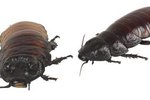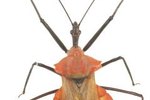Among the many varieties of venomous insects, some species are capable of projecting a poisonous or caustic substance from their bodies as a defense mechanism. These liquids are typically synthesized and sprayed from specialized organs located on a species's head or abdomen. The effects of such venom on humans range from mild and momentary discomfort to intense pain lasting hours.
Ground Beetles
Beetles belonging to the Carabidae family, also known as "ground beetles," have developed sets of glands along their abdomens capable of releasing a heated, acidic spray. Unlike some other flying insects, beetles cannot spread their wings and take flight rapidly, leaving them vulnerable to fast-moving predators. The spray, therefore, is believed to serve as a distraction to aid in escape. The family is widely dispersed across Europe, Asia and Africa. Some species, such as the African Stenaptinus insignis, can aim their venom glands in multiple directions by adjusting their rear legs.
Walking Sticks
Insects belonging to the family Phasmatidae are commonly known as "walking sticks" because of their strong resemblance to twigs or branches. This natural camouflage helps protect the herbivorous (plant-eating) walking sticks from predators. Additional defensive adaptations vary by species. A few, such as the American stick insect (Anisomorpha buprestoides, found in parts of the southeastern United States), are capable of spraying a mild acidic substance up to two feet from glands located in the thorax. American stick insects typically aim the spray at a target's face, causing discomfort and even temporary blindness if the substance comes into contact with the eyes.
Ants
Among the thousands of species of ants (family Formicidae), some are capable of producing a painful venom released via bite, sting or spray. Among the latter variety is the Camponotus consobrinus or "sugar ant," an Australian species that can eject an acid from its abdomen as a warning to predators. Entire groups of sugar ants may employ this tactic to defend a nest. A related species known as Camponotus saundersi has a more extreme defensive adaptation. Each segment of the saundersi is covered with poison glands. The animal can rupture these glands all at once if threatened, killing itself and releasing poison in all directions.





